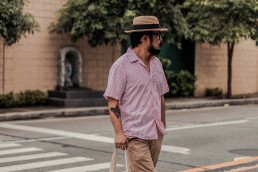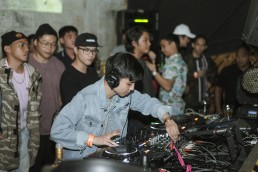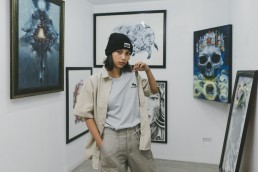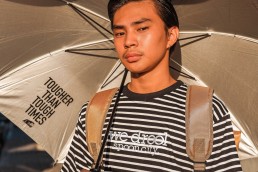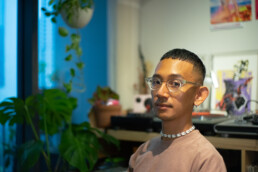
Designer, DJ, and a staunch advocate of the musical community, Sean Bautista, AKA Duality, is a musical purveyor, nightlife vet, and overall party confidant who’s been involved in the comings and goings of nightlife, nominally for his work in Tetsuo as both in charge of the sonic space and its design. From humble beginnings with his early introduction to musical creation and performance in his youth, to an exploration of Berlin’s music scene, to managing one of the most in-depth musical communes of collaborators co-contributors, and creators under Manila Community Radio, Sean’s journey not only reflects his personal observation of sonic and nightlife changes, but also serves as a reflection of the nightlife changes that had come since then.
With a change of culture, curating niche sets as opposed to focusing crowd-pleasers, building rapport with different owners as well as the agency of performance — all these things hold the scope of an established DJ, a co-owner, musician, but most importantly: a creative.
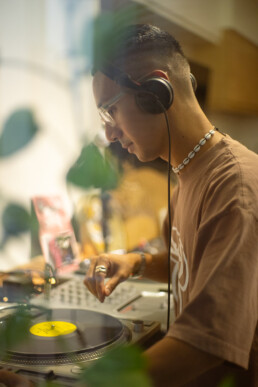
“I don’t make a huge living out of it, and that’s what has helped me keep a healthy relationship with it.”
How did you get into the world of clubs and DJing?
After working for some time in more design related work—cutting my teeth in fashion retail plus slowly building my own entrepreneurial ventures—I found myself burnt out by the industry and started to look for a completely new outlet outside of the visual arts.
I was always an electronic music/club kid, and I had grown up being surrounded by friends and collaborators who worked in audio. I dabbled in electro music when I DJ-ed in highschool and substituted university organizations with being a B-side and Black Market regular. I can’t say that I consciously made an effort to become a DJ but I somehow found myself exploring the discipline after seeking out a hobby outside of design.
Things just started to grow organically from there; I fell deep in the music rabbit hole through clubbing and nightlife. DJing turned into event promoting, which transformed into setting up an artist collective and house/techno imprint called transit records. I can say that my journey into music and the industry was pretty organic. From hobbyist, to listener, to events producer, label owner, and now community radio volunteer. It’s worth mentioning that I still consider myself to be an amateur and hobbyist in this entire thing. I don’t make a huge living out of it, and that’s what has helped me keep a healthy relationship with it.
Tell us about your time before entering the party and establishment scene. What’s your biggest inspiration for DJing and mixing?
I was more involved with my design practice before investing more time in the nightlife scene. I had been working more within the medium of creative direction, marketing, and identity design role for my own entrepreneurial ventures and as a freelance gig. As I mentioned earlier, I had been getting a little fatigued by focusing too much on design.
I guess the main tipping point or “inspiration” for me was visiting Berlin for the first time in 2018. I had already been rediscovering my love for dance music by attending club nights and smaller raves around Manila, but it wasn’t until I saw everything in context that everything clicked and I decided that DJing was something I wanted to participate in. I guess seeing the ecosystem of clubs, radio stations, label studios, record stores all in flux inspired me to also get involved with the scene back in my city.
What goes into making a good mix?
I think that the best mixes do what algorithmic playlists can not do. I find it most interesting when DJs are able to break from formulaic sequences by unearthing little known tracks, exploring niche sub-genres, weaving together seemingly unrelated styles of music, or by putting technical mixing skills at the forefront. A good mix tells a unique story through the lens of the DJ.
Is playing, mixing, or handling a set similar to making and recording music? How, or what sets them apart?
In my personal opinion, It’s an artform of its own. I often make the comparison between DJing and the act of curating. If making music is similar to creating artworks as artifacts, mixing is placing the artworks in context and creating a larger narrative—it’s arranging, sequencing, blending, connecting pre-existing works to form a message of its own.
Mulan, a local legend in the underground, once told me that he treated records as tools to create the mix. The entirety of the performance is the unique articulation that the DJ provides to the audience.
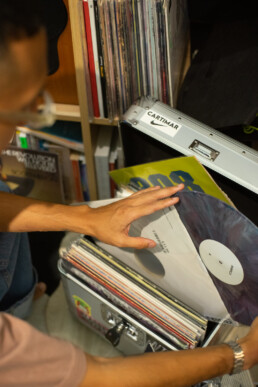
“In my case, the confluence of multiple fields is what contributes to my most unique and meaningful ideas.”
On your socials, you’ve linked yourself to transit records, Manila Community Radio, and even Tetsuo. Can you touch on your associations with them and what your time with them was like?
In university, I was interested in hospitality, specifically food & beverage, as a medium for brand and identity development. Restaurants are a blank canvas that could be designed through multiple visual and non-visual touch points—logos, menus, letterheads, and business cards but also flavor palettes, music playlists, customer/user experience, service design, and atmospherics. I liked how restaurants could also act as a third space that encourages social interactions and culture to thrive. I guess, as a designer, I liked how I could influence the look, feel, and interactions within a space. Whether it was our food stall in Mercato Centrale or our pop-ups in XX:XX—we always made sure to creative direct our marketing assets by making them look like rave posters or our non-visual touchpoints through the music playing in our speakers. We’ve slowly grown our small food stall (in 2016) into a full fledged two location restaurant in the last 5 to 6 years. We still serve food at a democratic and accessible price point, but we go above and beyond by designing experiences that build our relationship with our community of customers.
Radio is its own interesting story. I had been a fan of pirate radio since my university days and was really infatuated by its non-commercial context. As opposed to the club or commercial radio, which has direct or indirect ties with systems of capital, I loved how internet radio seemed to be all about sharing, discovering, and fostering interactions through music.
Jorge, of Buwanbuwan Collective and Kindred, shared the same enthusiasm for it and we actually had many conversations about building community radio pre-pandemic. When the pandemic hit, we were at a loss for venues to share and foster interactions around music. This gave us, as well as a wide list of collaborators, that extra push to work together on a decentralized platform that provided an avenue for artists to self-publish their work and discover new music.
I do believe that they all affect each other in more ways than one. I like viewing things holistically, and I’m allergic to the mono-culture that is propagated by being dogmatic with single discipline/s. In my case, the confluence of multiple fields is what contributes to my most unique and meaningful ideas.
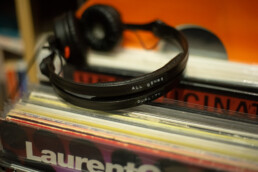
Let’s talk about transit records. What has your time there taught you about the music label business?
transit records started as an artist collective to house the activity of like minded DJs and producers—within our small community. Since the inception of the label, we’ve managed to host artist workshops + club nights, release music outside of the major label framework, and broadcast radio shows to stations around the world. Running a small label has allowed us to stick to our values and focus on the music we want to share and the experiences that we want to create. We’re taking things a step at a time, slowly growing our discography of music and diversifying our growing list of collaborators
I’ve honestly learned so much about my personal relationship with music through working on an independent label. I think there’s often a pressure with owning and running an imprint and trying to work towards operating at the scale of a major. The two couldn’t be more different and I think that you should constantly remind yourself of that as a label owner. While one operates under the systems of capital, the other is hinged on a more subjective set of values.
My relationship with music has benefitted so much by not conflating my why and how.
We created transit as a means to subvert existing frameworks within music—putting freedom and expression first and working on the business side along the way. Once you start obsessing over profitability and exploiting monetary value out of the label, you start undercutting the integrity or artistic value of what you’re trying to do in the first place.
“Running a small label has allowed us to stick to our values and focus on the music we want to share and the experiences that we want to create.”
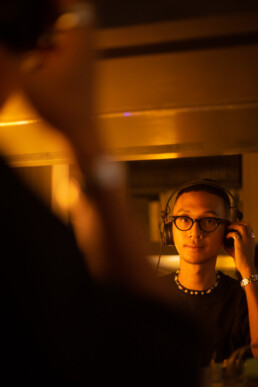
How has your experience as an underground DJ influenced your outlook on life and society? How did this influence your creative work?
Pushing for underground spaces and artists at the fringes has taught me about the importance of equity, mutual respect, and the spirit of openness. I’ve had to unlearn conventional frameworks of thinking and reassess my value systems when it comes to thinking about my creative work. It’s easy to use objective or profit-oriented goals as a barometer of success but it’s reductive and selfish to be solely fixated on those. Thinking about the cultural, emotional, and societal implications of the dance has allowed me to be more community-oriented and holistic with my outlook on life and labor.
“The party is just as good as the community behind it—an open-eared and -hearted dance floor is so underrated.”
What do you think is the key ingredient with keeping the scene—of clubbing, that is—interesting? Is it locale, visuals, day-by-day events, or gimmicks; something else?
I think that everything goes hand in hand and you can’t separate one thing from the other but I often think that we often have an artist-centric perspective with regard to how to keep scenes alive and interesting. What I’ve found is that the dance floor is just as important as any other facet of clubbing. Your party could have the best DJ but a closed off crowd. It’s important to cultivate a room of listeners who are just as open and responsive as the DJ.
To give a quick anecdote of this, I recently played a set for SadoMasoDisco. I really didn’t know where I was headed but wanted to stay true to myself and what I’ve been listening to by sharing music within the realms of bass, percs, post-dubstep, and electro. I was surprised because no matter what I put on; it seemed like the dance floor was just as excited to hear the music that was blaring over the speakers. After I did my individual set, I went back to back with Baby Ikea, a transit records label mate of mine. We moved into rave, breaks and techno and it was popping off before midnight. I was congratulated by a few friends after the set, but I told them that the dance floor made all that possible. The party is just as good as the community behind it—an open-eared and -hearted dance floor is so underrated.
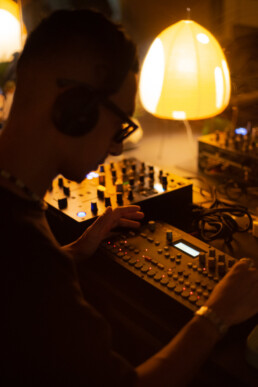
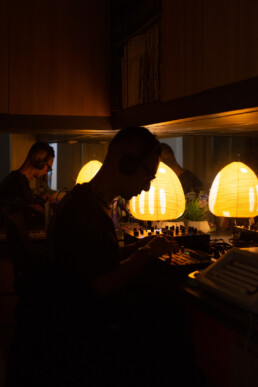
With that, what are some of the key elements that make for a successful nightlife scene, and how do you work with other stakeholders like venue owners, promoters, and designers to create these experiences?
One of the key elements that’s often left out of the conversation is the importance of the dance floor. You can have the best DJ or venue, but if no one is engaging with the music, your party is shit. Community is everything. If you’re able to bring together a diverse, genuine, open-minded and -hearted group of people; that cascades to DJs and promoters being able to push boundaries and create more meaningful experiences.
How do you balance catering to the expectations of your audience while still maintaining your creative vision and pushing boundaries?
I think a lot of it boils down to your individual relationship with music and knowing in which scenarios you can create value through sharing your work. I’ve come to realize that everyone enters the DJ thing for different reasons and finding the right audience for your work is often the crux that one has to face. My relationship with music is centered around discovery, experimentation, and sharing. That being the case, I make an effort to put myself in scenarios where I can do those very things—through being selective with my bookings and seeking our communities that share a similar set of values.
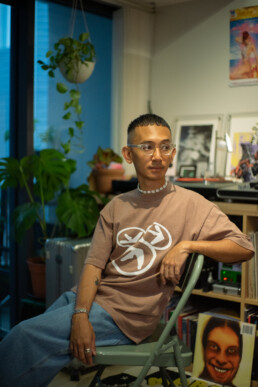
Regarding night life, mixing, and live entertainment, what’s something you wish people realized more?
From my vantage point, design and music communities are comfortable working within their own niches. Often, I see groups that reinforce a monoculture by being protective of the spaces that they’re in. I understand that this is natural given the value systems that we’ve grown up to learn, but the short sight of this culture is that it leads to nepotism, gatekeeping, and the politics of a ruling/dominant group. I hope that we see more cross pollination within the communities that we occupy.
What my colleagues and I have recently been obsessed with is trying to reimagine what our industries might look like if we take more influence from our vernacular sensibilities or visual language. I think one of the challenges that we face within design or music are western or eurocentric aesthetic standards of how our creative output is expressed.
This could be in the form of designs being discounted as amateur for not fitting modernist trends that are dictated by a globalized and capital-driven economy. Or how certain music is expected to be played in certain clubs or establishments to project a more upscale vibe. While, from a business perspective this is valid because those are the kinds of experiences or services that are sought after by the spending market, I also think that it’s a hindrance to more authentic and unique forms of creative expression.
CREDITS
WRITER Jean-Pierre Ditona
EDITOR Tricia Quintero
PHOTOGRAPHER Sai Versailles
SUPPORT PURVEYR
If you like this story and would love to read more like it, we hope you can support us for as low as ₱100. This will help us continue what we do and feature more stories of creative Filipinos. You can subscribe to the fund or send us a tip.

